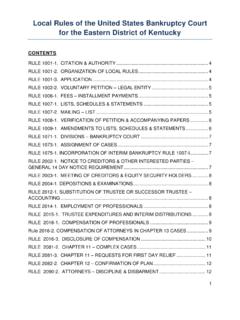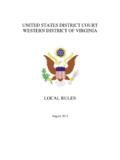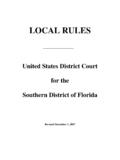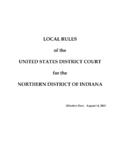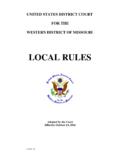Transcription of CCH BANKRUPTCY REFORM ACT BRIEFING: …
1 CCH BANKRUPTCY REFORM ACT B Re portHIGHLIGHTS Means Testing Required Reduced Superdischarge Priority Child Support Military Accomodations Automatic Stay Exceptions Expanded Credit Counseling Exemption Law Changes Retirement/Education Savings 180-Day Effective Date DelayIntroduction ..1 Consumer BANKRUPTCY ..1 Consumer Protection ..3 Abuse ..5 Highlights of Other Changes ..6 Effective Dates ..7 InsideBankruptcy Abuse Prevention and BANKRUPTCY Abuse Prevention and Consumer Protection Act of 2005 Consumer Protection Act of 2005 BANKRUPTCY Overhaul Enacted New Rules for BANKRUPTCY ImplementedAfter seven failed attempts and mas-sive lobbying largely by banks and credit card companies, the Bankrupt-cy Abuse Prevention and Consumer Protection Act of 2005 (S.)
2 256) was signed into law by President Bush on April 20, 2005. Most provisions of the law are effective October 17, 2005. The Act was passed by the Senate in March and was approved by a vote of 302-126 in the House of Representa-tives on April 14, 2005. The legislation represents the largest overhaul of the BANKRUPTCY Code since its enactment in 1978. The intent of Congress was to improve BANKRUPTCY law and practice with a dominant theme of restoring personal responsibility and integrity in the BANKRUPTCY system. The 2005 Act largely impacts con-sumer BANKRUPTCY , but has provisions affecting corporations, farmers and small business. The 2005 Act also has many important provisions for securities, fi nancial contracts, privacy, taxes, cross-border cases, health care and employee benefi ts and consumer credit disclosures.
3 Comment: The defeat of the con-troversial Schumer amendment regarding nondischargeability of certain fines incurred during illegal abortion protests paved the way for BANKRUPTCY REFORM by Congress. Several Senate amend-ments, including a special home-stead exemption for the elderly, exemptions from means-testing for all veterans and debtors in bank-ruptcy due to medical expenses and identity theft were soundly defeated. No amendments could be offered during the two hours of House debate. Special accom-modations are made, however, under the Act s income-test for active-duty military personnel, low-income veterans and those with serious medical BANKRUPTCYC ongress has passed a comprehensive set of BANKRUPTCY reforms in response to several factors, including escalating BANKRUPTCY fi lings, signifi cant creditor losses associated with BANKRUPTCY , loopholes and incentives in the cur-rent system that allow for opportu-nistic personal fi lings and abuse and lack of fi nancial accountability.
4 The consumer provisions are specifi cally targeted to address factors contribut-ing to escalating fi lings and abuses in the system such as the proliferation of serial fi lings and the absence of effective oversight to eliminate abuse in the system. The Act creates new responsibilities for those charged with administering consumer BANKRUPTCY and those who counsel debtors to achieve BANKRUPTCY relief. UPDATED APRIL 21, 2005 2005, CCH INCORPORATEDCCH BANKRUPTCY REFORM ACT BRIEFING UPDATED APRIL 21, 20052 The Act lowers the substantial abuse standard for dismissal or conversion to one of simple abuse. Means TestingAt the heart of the Act is the means test, designed to force those debtors who have the ability to pay some of their debts into Chapter 13 as op-posed to liquidating under Chapter 7 and wiping the slate clean.
5 The Act would eliminate the presumption that, without a finding of substantial abuse, a debtor is entitled to relief under Chapter 7. Instead, a debtor s Chapter 7 case would be dismissed or, with the debtor s consent, con-verted to Chapter 13 upon a finding of abuse. The Act lowers the sub-stantial abuse standard for dismissal or conversion to one of simple abuse. Whether abuse would be presumed would depend on the outcome of the means test that projects the debtor s current monthly income, less specified expenses, over a five-year period. Under the means test, a debtor at the low end of the income range would remain eligible for Chapter 7 relief if the amount of his or her income net of expenses is less than $100 per month ($6,000 over five years).
6 At the high end, a debtor would not be eligible for Chapter 7 relief if his or her net income is equal to or exceeds $ per month ($10,000 over fi ve years). In the middle are debtors whose net monthly income is $100-$ ($6,000-$9,999 over fi ve years). If income less expenses multiplied by 60 is between $6,000 and $10,000 conversion or dismissal is only required if the debtor has suf-fi cient income to pay 25 percent of nonpriority unsecured a nutshell, debtors whose net current monthly income exceeds their state s median income would be sub-ject to a means test. A bright line rule for abuse is created requiring dismissal or conversion pursuant to BANKRUPTCY Code Sec.
7 707(b)(2)(A)(i) if:the debtor had at least $ in current monthly income after the al-lowed deductions, ($10,000 for fi ve years), abuse is presumed regardless of the debtor s unsecured debt; orthe debtor had at least $100 of such income ($6000 for fi ve years), abuse is presumed if the income is suffi cient to pay at least 25 percent of the debtor s nonpriority unse-cured debt over fi ve years. EXAMPLE: Lisa Brown s net monthly income exceeds that for the median of the state of Illinois. After deducting allowed expenses, Lisa has $150 net monthly income. She has $35,000 in unsecured nonpriority debt. Lisa passes muster under the fi rst prong of the means test because her net monthly income after deductions is less than $ Over a fi ve-year period, Lisa could repay $9,000 of her unsecured debts.
8 Abuse would be presumed because Lisa could repay at least 25 percent of $35,000 or $8,750. Thus, Lisa is ineligible for Chapter 7 relief. Assuming in the same scenario that Lisa had $40,000 of unsecured nonpriority debt, Lisa would be eli-gible for Chapter 7 BANKRUPTCY . Lisa is ineligible for Chapter 7 relief if she can pay at least 25 percent of $40,000 or $10,000. Since she could only pay $9,000 of the unsecured debt, she is eligible for Chapter 7 presumption of abuse may only be rebutted with detailed docu-mentation of special circumstanc-es requiring additional expenses or adjustment of current monthly total income for which there is no reason-able alternative.
9 Calculation of Income and ExpensesThe Act strictly construes amounts that debtors can claim as expenses. Reasonable monthly living expenses are specified under IRS standards. National standards establish allow-ances for food, clothing, personal care, and entertainment depending on the debtor s family size. Under means testing, if reasonable and necessary, debtors are allowed an increase up to 5 percent on the food and clothing allowance. Local standards establish allowances for transportation on a re-gional basis and housing on a county by county basis. A third category of ``other necessary expenses is recog-nized by the IRS for which it does not specify an allowance.
10 IMPACT: The amount of plan pay-ments is based on IRS allowances and other expenses (excluding pen-sion loan repayments and Social Security) based on a six-month average minus amounts necessary for support of the debtor, postpeti-tion domestic support obligations, charitable contributions up to 15 percent of gross income, and pub-lic or private school expenses up to $1500 annually per child per year subject to certain restrictions. Deductions are also allowed for expenses for protection from family violence; continued contributions to care for nondependent family members; actual expenses to cure an arrearage of the debtor s mortgage on his or her residence, automobile or other property necessary for sup-port, divided by 60; and additional home energy costs.




